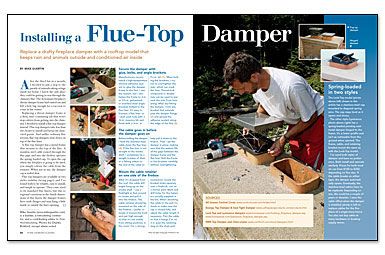Installing a Flue-Top Damper
A rooftop model keeps rain outside and conditioned air inside.

Synopsis: Fireplace flue dampers don’t necessarily last forever. Rhode Island builder and contributing editor Mike Guertin recommends replacing a damaged throat damper with a flue-top model. A damper atop the chimney helps to keep conditioned air inside a house, and it prevents animals from taking up residence in the chimney. A cable that runs from the damper to the fireplace opening allows the spring-loaded damper to be opened and closed easily. Guertin describes the two styles of flue-top damper (pop-up and spring-loaded) and offers installation advice.
After the third bat in a month, I decided to put a stop to the parade of animals taking refuge inside my house. I knew the only place they could be getting in was through the chimney flue. The downstairs fireplace’s throat-damper frame had rusted out and left a hole big enough for a raccoon to come in last winter.
Replacing a throat-damper frame is a dirty, time-consuming job that won’t stop critters from getting into the chimney. I decided to install a flue-top damper instead. Flue-top dampers take less than two hours to install and keep out uninvited guests. And unlike ordinary flue screens, flue-top dampers close down on top of the flue liner.
A flue-top damper has a metal frame that mounts to the top of the flue. A stainless-steel cable routed through the flue pipe and into the firebox operates the spring-loaded cap. To open the cap when the fireplace is going to be used, you simply release the cable from the retainer. When not in use, the damper cap is sealed shut.
Flue-top dampers are available in two styles, and I’ve found both to be reliable, easy to install, and simple to operate. They come sized to fit standard flue liners, but due to regional variations in the finish dimensions of flue liners, the damper frames have wide flanges and may hang a little inside or outside the liner opening.
Spring-loaded in two styles
The Lock-Top model shown in this article has a stainless-steel cap mounted to diagonal spring wire. The cap stays level as it opens and closes.
The other style has a spring-loaded pivoting cast-metal damper hinged to the frame. It’s a lower profile and isn’t as noticeable from the ground when opened. The frame, cable, and retaining bracket mount the same as with the Lock-Top model.
I’ve used both styles of damper and have no preference. Both install and operate similarly. Prices for both models run from $150 to $350, depending on flue size. If the cable breaks on either type, the damper automatically opens. Eventually, the stainless-steel cables have to be replaced. Depending on use, this could be a couple of years or decades. I save the cable offcut when the damper is installed; plenty is left to replace cables for the fireplace of a single-story home. You also can buy cable at many hardware or boating-supply stores.
For more photos and details, click the View PDF button below:

























